Russ speaks to Bobby about his time in prison and what he felt when he took part on a Good Vibrations course.
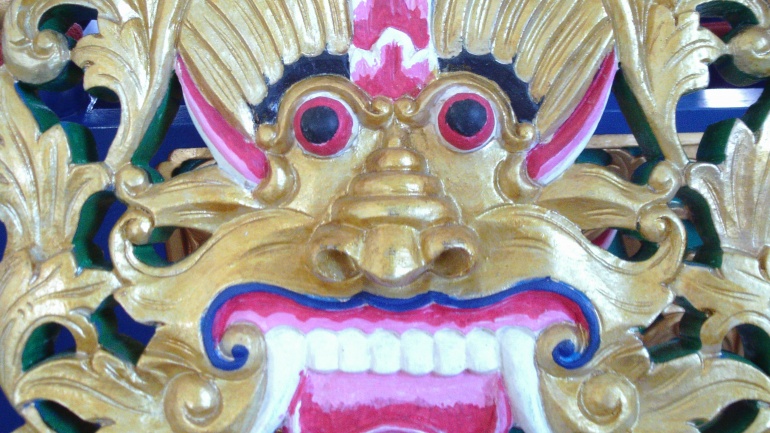

Russ speaks to Bobby about his time in prison and what he felt when he took part on a Good Vibrations course.
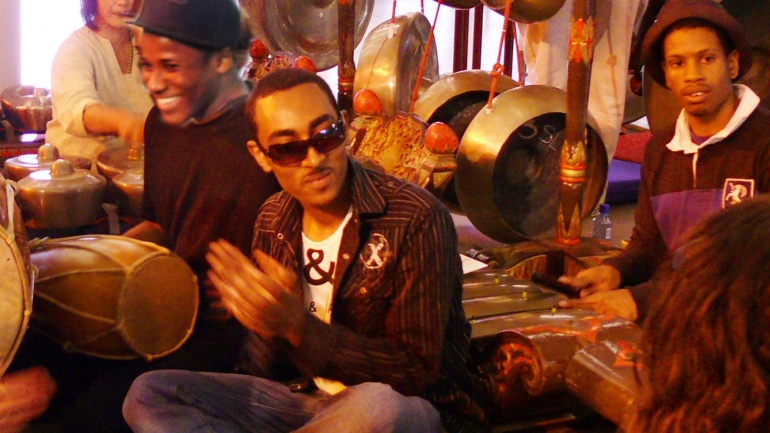
Sam speaks to Jeremy Gilbert, an academic at the University of London, DJ and historian of dance music culture. They speak about affect and collective joy in relation to communal music making.
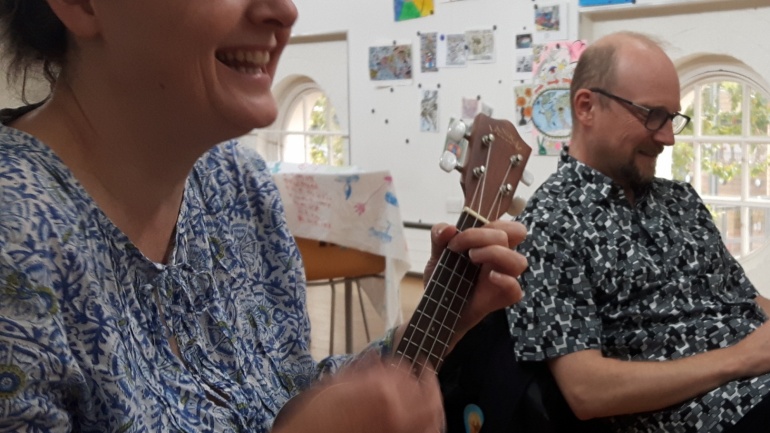
Sam speaks to Mags Smith, a community musician and workshop facilitator for Good Vibrations. Mags reveals how and why she discovered a passion for storytelling, and the relationship between storytelling and healing.
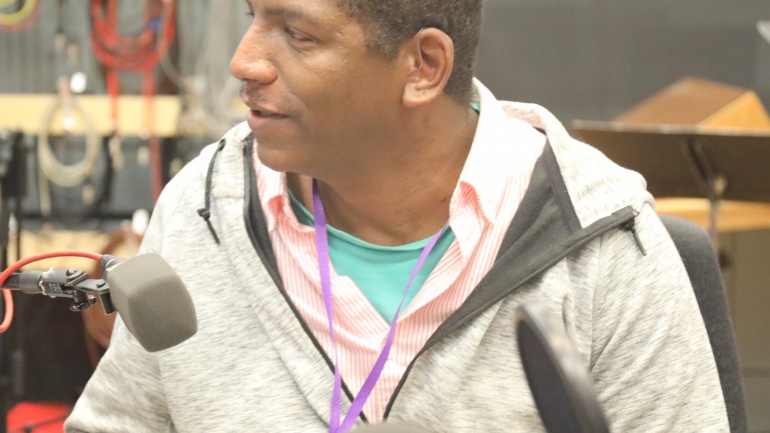
Sam speaks to Russ Haynes, a past-participant and advocate for Good Vibrations. He speaks about first encountering Good Vibrations while living in a half-way house hostel after a period in prison.
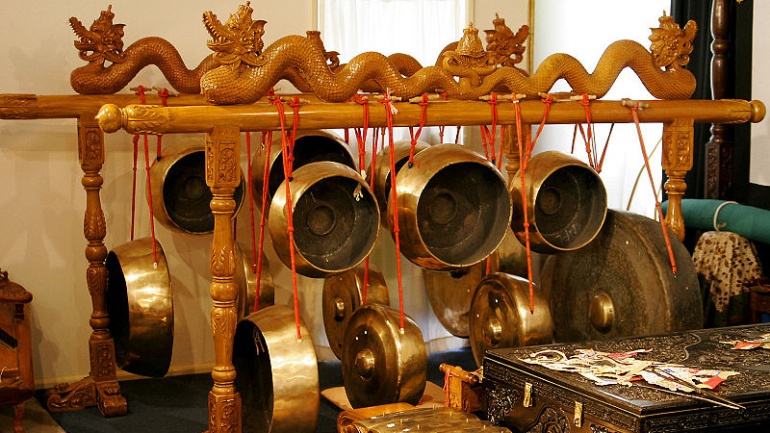
Sam speaks to Paul Brewer from Sound Minds, a service user led arts and mental health charity based in Battersea. They discuss the power and healing effect of collaborative music making.
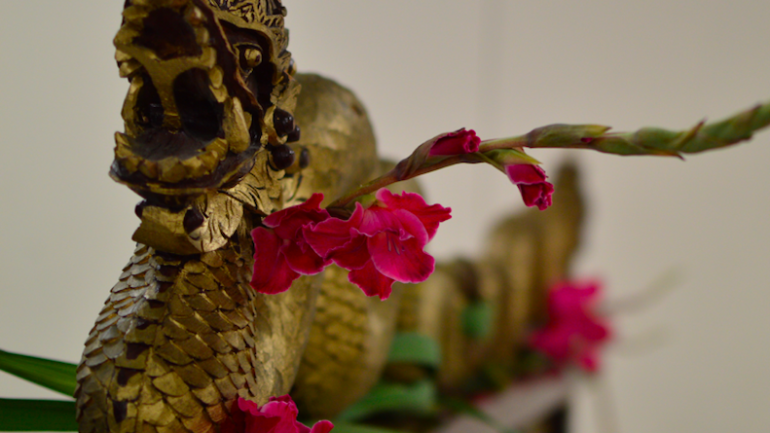
Sam speaks to Rachel Tribe, a clinical psychologist at University College London whose research interests include exploring the relationship between creativity and mental health.
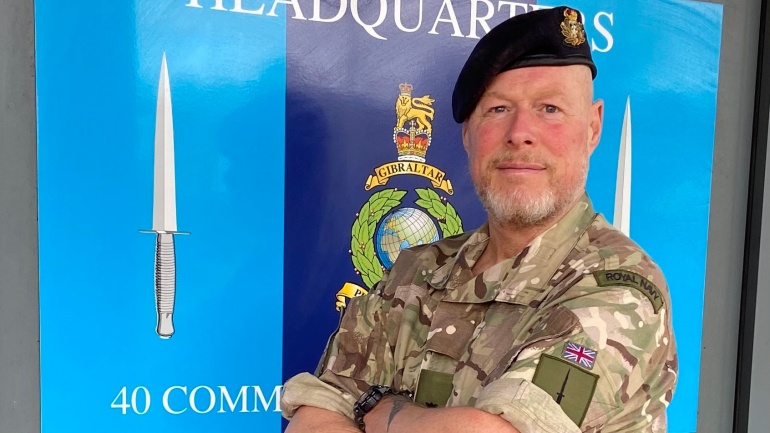
No. 1 in our blog series exploring creative approaches to transforming the criminal justice system.
Author: Dave Jeal, Chaplain
Can you tell us about your time working as a prison chaplain?
I’ve been a chaplain for over 22 years – first in HMP Ashfield, then at Bristol Rovers football club, and now in the Royal Navy serving with the Marines. They’ve all been working with completely different demographics.
HMP Ashfield housed young offenders and juveniles when I was there. I come from a working-class Bristol background and struggled myself when I was young, so I felt the lads were in some ways similar to me. They trusted me and I wanted to help if I could. They needed someone to believe in them. Just offering hope was my main task.
While I was working at the prison, I set up a church in one of the big council estates in Bristol, an area that was in the top ten indices of multiple deprivation in the UK. It was somewhere the lads could come when they were released and be taken care of.
What are some of the factors that lead to people to offend?
From personal experience of getting into trouble at a young age, I didn’t fit into any educational structure at all. I hated school with a passion. I’m dyslexic and most of the guys I talked to in prison had some sort of learning disability as well. Once you disengage, you’re very limited with what jobs you can go for, and you’re probably angry because you’re being told you’re lazy and stupid. Then it spirals out of control because you think, if that’s what you think of me, then watch this!
Most of the guys were not lazy or stupid at all. They just learned in a different way and were actually quite clever, but they were frustrated. We have a one-size-fits-all education system and it fails, and it makes people angry. They can’t fit into what society wants them to be, so they kick off, get arrested and feel hopeless. Then they live out their childhoods for the rest of their lives – unless there’s some break, they keep going back to it. In the Bible it says a dog always returns to its vomit. I can do that myself – keep going back and doing the same thing, even though I know it’s broken. And that’s what they’ve learned from an early age – that they will never be any good, so they might as well live that out.
It used to be £56k to lock up a young person for a year. It’ll be more than that now. How much would it cost to send them to a public school where they’d get a really good education? It’s got to be cheaper than putting them in prison. And the misery they’re causing themselves, their families and the victims of whatever crime they committed – why would you put them through that? You’ve got so many clever people that the country could tap into, and we’d all be much better off.
Everything is pushed towards the end goal of exams, and if you’re no good at them, what are you going to do? It gets passed down in families, so if the generation before you has failed in the world’s eyes, they say ‘don’t bother – that’s not for us’. My wife was the first person I knew who’d been to university. She helps me; my eyes have been opened and my horizons have changed.
When the prison sent us to America on a gangs conference, the one thing I saw in US prisons that worked was the boot camp. It gave a sense of belonging, hope and identity. Americans are very proud of their flag and rally behind it, but we don’t have that here. Not only do we have a class system, but we’re fragmented in lots of other ways too. What do we have that unites us?
What are your thoughts on education in prisons?
Not everyone is academic. We need to find out what each person is good at and focus on that. Doing something you enjoy helps in other ways too. I like knives and axes. I get together with some of the Marines where I work now, who might be struggling with PTSD, we make knives and sheaths together. They love I and I love it, and it helps them to open up.
People know if you’re a shepherd or a hired hand. You can’t kid a kidder. If you’re a hired hand – that’s your job, but if you’re a shepherd, you care for those sheep – they’re your sheep. People who actually have a passion for justice and for the people they work with in prisons – that’s what’s going to work. If you employ people who are innovative and do things a bit differently, they will attract other people who will try exciting new ways of doing things too. Then things will change. We have to do things differently because it’s not working at the moment.
People with dyslexia are highly represented in prisons. How can they be better supported?
Whether you have dyslexia dyspraxia, or dyscalculia, you need a lot of additional help. Schools don’t have the time, money or expertise to really make a difference. There’s a brilliant centre for dyslexia in Bristol, but it costs money. Specialist support should be more widely available. It is estimated that up to 85% of male offenders have some sort of learning disability – it’s not just a few people. And they’re the ones that got to prison. How many more didn’t get to prison, but are facing similar problems?
There are over 80,000 people in jail right now, costing the country a lot of money and a lot of misery. Spend it on doing something positive for those people and for the country, because they’re very bright, clever people. They’re valuable.
How does faith help people in prison?
I say to the lads, OK, so you’ve made some mistakes. Well, let’s have a look at some of the people in the Bible, and see what bad things they did. You’ve got murderers, thieves, all sorts in there. But God can use them, and he tends to use them more than the people who’ve got it sussed. I quite like things to be a bit prescriptive. Maybe that’s why I like the military. The Bible says, ‘don’t do that, because this is going to be the outcome’. It’s easy to understand and it gives you a sense of belonging.
I’ve found church quite difficult because you have to read a lot, and also it’s very middle class. When I first got involved, people would ask me to come round for a meal. I didn’t know anyone who would do that. And all the singing songs and playing music – it was odd to me. I remember once, someone asked me over for a meal and then took out his guitar and started singing. I freaked out and left. I didn’t realise it was normal in that church.
I grew up in a very, very white working-class estate. I’ve learned as I’ve grown older to be a bit more open minded, but when you come from a council estate, that’s all you know. The thing is to learn to open your eyes and find out what the world is like.
We need to stop putting people into boxes. There are some things you’ve got to conform to, like not breaking the law, but on the whole it’s good to be able to express yourself and say ‘this is how I feel’. Everyone needs the chance to be heard and told that their point of view is valid.
Veterans can be vulnerable to offending. What can we do as a society to help them?
Most of the lads are quite young in the Marines. When they leave, they’ve spent their lives being told what to do and have become institutionalised. There is a resettlement programme, but they still don’t really know how to look after themselves.
They’ve built really strong bonds and a sense of identity and belonging that they’ll hold onto for the rest of their lives. Once a Marine, always a Marine. But they may not be with other Marines and there’s this sense of grieving.
That’s where organisations like the church could do more and should do more. We’re supposed to be a community for every living soul; we’re to care for them and love them. The church doesn’t always do that very well. No matter who you are or what you’ve done, my role is to be there and help you on your way.
Do you have any final words of advice?
Do things that really help people change:
At HMP Ashfield I took some of the lads abroad to give them new experiences. Every year I took some to football camps in Albania. It broke their hearts. They thought they were poor living on estates in Bristol, but these guys didn’t even have any shoes and their living conditions were terrible. They were lovely people, and the lads wanted them to know that they cared about them and that weren’t forgotten. Thinking about all the guys I’ve taken on these trips, I reckon 75 – 80% haven’t reoffended again. I’m still in contact with some of them now.
Find out what rocks their boat:
Everyone has a skill that no one else has got and when they find that, they’ll be absolutely outstanding. We just need to help them find what it is and polish it. It needs to start from an early age and keep giving people opportunities to try different things.
Give them hope:
They need something they can hold onto that’s for real – not just a concept. They need belief, to feel part of something and feel cared for. These are just basic humans needs.
Hope can help break the cycle.
_______
Good Vibrations has worked in prisons and young offender institutions since 2003. We see the destructive effects on people of living within our overstretched, under-resourced criminal justice system. We want to understand how people can be better supported before, during and after their contact with the criminal justice system. We have commissioned a series of blogs from a range of experts, including those with lived experience and their families. Every Thursday for the next four months, we will bring a different voice with their own unique perspective and ideas. At the end of the series we will publish a report drawing together the themes and recommendations.
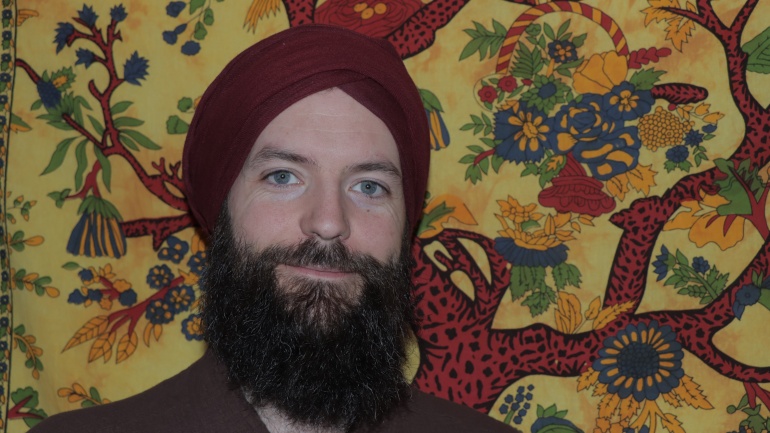
Guest Author: Anu Koechli
As human beings one of the most fascinating elements of our species is our creative capabilities with the creation and development of music over tens of thousands of years. Recent technological developments over the last few decades have allowed for scientific discoveries showing how sound frequencies are proven to promote healing both physically and mentally through using instruments or bio-resonance devices. Below we will explore a small collection of ancient instruments from various cultures with a focus on Gamelan, my experience of attending Gamelan sessions with Good Vibrations and some information on the connection between sound frequencies and the Universe itself.
Our planet exists in a sound and communication orientated universe. Our ancient civilisations knew about this and respected it so which is why one of the main constants we have throughout history is the evolution of music along with the evolution of humans since our very ancient ancestors first figured out how to use animal hide stretched over carved tree trunks to create drums.
Drumming circles are believed to be one of the first musical instruments used in early tribal culture in early Gondwanaland – the first large continent of the earth before tectonic plate movements that split land into different pieces, but we can trace the early developments of drums to what is now Africa. Drumming combined with singing and chanting brought humans together in celebration or ceremony. Over tens of thousands of years humans have developed a vast spectrum of instruments to create sound, to play with different sounds and create music that enabled us to explore not only the exterior physical dimension we live in and how it works but also allowed us to explore deep within ourselves what we are capable of creating and how we communicate with each other.
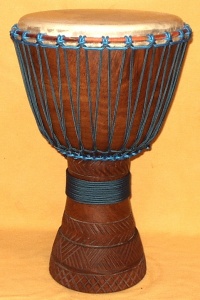
(Source: Djembe Art, CC BY-SA 3.0, https://commons.wikimedia.org/w/index.php?curid=18082929)
When you start to explore the rich variety of musical instruments around the world in different cultures and tribes it becomes intriguing how our ancestors must have gone through a lot of trial and error to figure out how to carve and build some of the most beautiful instruments out there.
Australian Aborigines created didgeridoos from finding dead tree branches that were hollowed out by rot and termites, though modern ones are made by splitting a tree branch in half and carving out the middle. They’re used by Aborigines in Dreamtime stories that show the didgeridoo as an essential tool in the creation of the world as well as a device invented directly by the gods and they class it as a sacred instrument which is used in both public and private religious ceremonies.
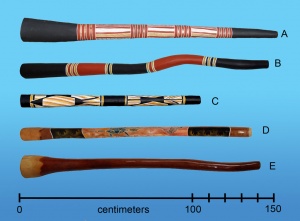
(Source: By Hmarin – Self-made image, from photos of my didgeridoo collection, Public Domain, CC BY-SA 3.0 https://commons.wikimedia.org/w/index.php?curid=19164391)
Ancient South American Incas created panpipes made from hollowed out bamboo or reed canes strapped together in varying lengths that create beautiful melodies that bring to mind a relaxing sense of calm and serenity which many of these people lived by up in the Andes, growing their own food, having spiritual ceremony together and paying respect to the eagle as it flies overhead.
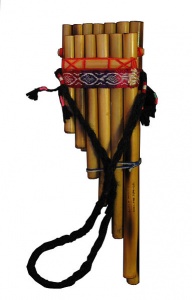
(Source: Photograph by Andrew Dunn. Website: http://www.andrewdunnphoto.com/, CC BY-SA 1.0, https://commons.wikimedia.org/w/index.php?curid=268710)
The Kora of West Africa and Sitar of India are both created from either dried and hollowed out Gourds or Pumpkins with a long wooden neck that allow for several string to be attached, that once played in harmonious melody can transport our minds away from the problems we face in the physical world almost to a higher and happier state of consciousness.
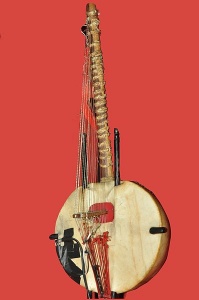
(Source: By KannanShanmugamstudio, Own work, CC BY-SA 3.0, https://commons.wikimedia.org/w/index.php?curid=18077100)
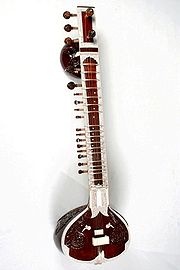
(Source: https://en.wikipedia.org/wiki/Sitar)
It becomes clear to see how over long periods of time different tribes around the world have created instruments based on the materials they have around them which are then very unique to their own culture that have helped develop their own societies as music brings people together for celebration, religious or spiritual ceremony, for meditation and even funerary gathering but what seems more evidently important for us as humans that we can use music as a way of communicating emotions and stories to each other with or without the use of language.
As written down in the Vedas of ancient India, Om is believed to be the primordial sound frequency of the universe we live in and is a sacred sound used in Hinduism, Buddhism and Jainism.

(Source: The Unicode Consortium – Derivative work of Om symbol.svg, Public Domain, CC BY-SA 3.0 https://commons.wikimedia.org/w/index.php?curid=54100842)
Om refers to Atman which is the soul or self within as well as Brahman that is consciously imagined as the entirety of the universe, an expression of truth and divine supreme spirit or consciousness with cosmic principles of knowledge.
The Helical vortex model of our planetary movements around the sun shows a pattern on a linear 2D diagram that resonates with that of sound sine waves and the shapes of the conch shell, which in itself is one of the ways the universe expresses the Fibonacci sequence of: 0, 1, 1+1=2, 1+2=3, 2+3=5, 3+5=8, 5+8=13 and so forth ad infinitum that gives us the Golden Ratio. Mathematics expressed in the universe which over thousands of years humans have discovered that reflect a divine creation blueprint of our universe which shows itself in the cosmic creation of conch shells, sunflower heads, snail shells, ammonites, pines cones & cacti. There are ties with the Fibonacci sequence in musical scales and harmonies.
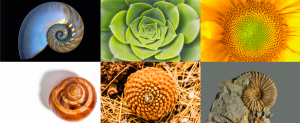
(Artist :Alex Rainsford, Anu Design)
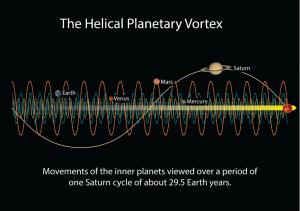
(Artist: Alex Rainsford, Anu Design)
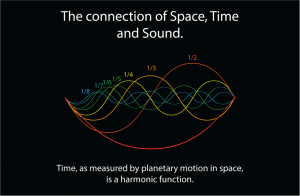
(Artist :Alex Rainsford, Anu Design)
Could it be that over time our interest in music as a form of communication is not also to understand our own expression of emotion and to bring us together during times of celebration, religious ceremony and even during times of hardship from warring, plague, drought & famine but also to unite us continually throughout time to resonate and communicate with each other and the universe itself?
Even the atoms and molecules that make us are almost entirely made of sound, which in turn, is frequency and vibrations. In order to attune ourselves to a higher level of awareness then, we often rely on the vehicle of sound. Whether it be chanting, playing an instrument, or even our own breathing, sound inspires us and invites us to explore and express what is within.
Whereas Balinese Hinduism existed for many centuries in Indonesia where 83% of the population identify as Hindu and the rest of Indonesia is predominantly Muslim, Gamelan music predates the Hindu-Buddhistic culture & spiritual belief systems that spread from India throughout South-east Asia between 850 and 600 BCE. The traditional ensemble arrangement of Gamelan music originates from Indonesia which consist of 17,000 islands that include Java, Sumatra, Borneo (Kalimantan), Sulawesi, Papa New Guinea and Bali.
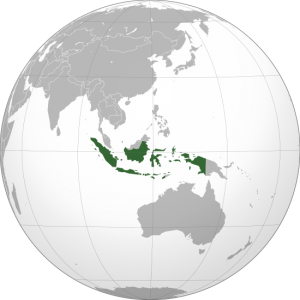
(Source: Addicted04 – https://commons.wikimedia.org/w/index.php?curid=8376146)
Gamelan ensemble music is created of an orchestra of instruments that comprise of hand-played drums, large bronze gongs, brass bells in varying sizes placed on meticulously carved wooden frames, brass plates also in scaled sizes on wooden frames that once created and tuned correctly to each other harmonise melodies that are very unique to Indonesia.
Sang Hyang Guru was a god king who ruled over Java from a palace on the Maendra mountain in Medang Kamulan, which in Javanese mythology is said that the instruments of gongs were created to summon the gods along with singing and shadow puppetry. To create complex messages of communication with the gods he created several differently tuned gongs which became the structure of Gamelan. The word itself, Gamelan, actually comes from the Javenese word ‘Gamel’ which is related the method of striking percussive instruments with a mallet and in Sudanese it is referred to as ‘Degung’. Degung is literally an ancient Sudanese word for gong and gong ensembles.
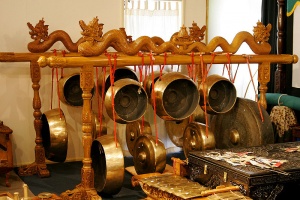
(Source: By fir0002flagstaffotos@gmail.com https://commons.wikimedia.org/w/index.php?curid=445401)
The first piece of Gamelan music I heard and loved was from the BARAKA soundtrack composed by Michael Stearns in a track entitled ‘Finale’ with the scene ‘Kecak’, whereby one of the most beautiful films made in human history shows a lady walking amongst rice paddies and then cuts to scenes of Cambodian temples of Angkor Wat, finalising in a spectacular recording of Balinese shamanic ritual chanting.
It was till years later after watching and loving the film BARAKA that I was introduced to Good Vibrations and Gamelan music sessions through a dear friend, Mike, which were hosted at Middle Street Resource Centre in Nottingham with lunchtime interactive classes led by Nikki.
Through going to Good Vibrations Gamelan sessions I became in much admiration and awe of the fantastic work of the Good Vibrations team, learning how you have implemented what could be classed as an ancient and tribal originating form of music creation and communication to help people around the UK in prisons and those working through mental health challenges.
As a musician I grew up first learning to play the violin at school which I quickly put down after a few years once I learnt more about classical music in the history of Europe and its links to a mentality of pomposity, class divide and wealth that has plagued and divided humans for too long. I moved onto the electric guitar as I grew up in my teens and was listening to albums by the Beatles, the Doors, Led Zeppelin, Camel, Pink Floyd, Van Halen, Rammstein & a plethora of many more 60’s / 70’s psychedelic rock’n’roll and later 80’s and onwards metal.
Many years later I’ve now found a much more appreciative love for the violin by putting to one-side classical music but learning how the instrument itself is crafted by hand using the divine proportions of the Golden Ratio.
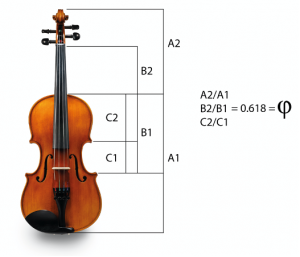
(Artist: Alex Rainsford, Anu Design)
At that stage in my life it felt like I was resonating with that form of music as the artists would convey lots of emotions in their melodies and lyrics. Over many years as my music tastes changed I developed a love and appreciation of World music, especially calmer more relaxing meditative ambient and ethnic music from different parts of the globe that I became attracted to at the same time as I focussed more attention to follow Buddhism and Hinduism on a bodhisattva path, which have helped tremendously to overcome the mental health stresses and problems I faced 15 years ago.
During the interactive Gamelan sessions with Nikki we would learn about the culture of Indonesian music and how they also treat their instruments as sacred pieces of temple like art, and learn about the different interlocking melodies played.
Anyone who wishes to join the session can choose which piece of Gamelan instrument or combination of instruments they wish to sit with that day and learn about Gamelan melodies which are first taught with series of numbers but with a continual feedback reminder from Nikki that once we learn the pattern we should use our ears to learn the melody and not the numbers.
Once I got over that mental hurdle everything started to make more sense as we individually would be remembering our own melodies which can seem tricky to play to start off with but get easier quickly over time with muscle memory and really using our ears. Nikki creates a very calm, open & responsive presence in the space as a musician and teacher facilitator that allows for people to both learn interlocking patterns & melodies during part of the session & intermixed with time to spend on free expression & experimentation of communication with each other through melodies we have learnt previously and adding bits of melodies we can create on our own.
Different people come to each session sometimes and there can be regular faces that come and it’s always been a pleasure to see them again and then build on what we learnt from the last sessions, learning more and creating something different each time. Nikki has been very dedicated and kind to record the practices on a Zoom Dictaphone which saved as wave audio files she then can send out to us by email to listen back to later on in the week for positive reflection and remembrance of the peaceful atmosphere created that day that seems to linger with me afterwards for sometimes up to a week in my head.
I believe now I can attribute my re-ignited passion for music production on Ableton, which I had put to the wayside many years ago during a period of depression, gratefully to the Good Vibrations team and to Nikki for hosting these sessions. I’ve learnt how to be open and responsive to other people more again through playing melodies with each other and keeping in tempo with people in the room. One meditation pondering brought me to the awareness that part of my depression in the past may have been due to my disconnect with instruments.
Keeping in tempo with other performers in the Gamelan space is critical for the musical journey to be created smoothly without off-beat or disharmonious sounds.
We were asked in one of the weekly emails to check out a link Nikki shared on some gamelan performances that came with recordings of that weeks recordings and create something in response to send back be it a piece of music, poem, a painting or anything creative that has inspired us.
From one of the audio recordings sent out by Nikki I sampled short and long loops of different stages of a practice session, which I played around with adding reverb & creating some percussion beats that subtly started to create the idea of a story in my mind. I’d recently been learning to sing the Shurangama mantra in Sanskrit which is a devotional mantra in honour of Amitabha Buddha which once translated in the full text honours the various Buddha deities that also removes negative energy from the mind consciousness and physical reality when chanted & wardens off evil and is well known as a protection mantra. I added vocal recordings of the intro of the mantra along with my Omming recording that brought me to a place of serenity and helped to compose the track together into a piece that I wished to share back with Good Vibrations to share with everyone freely for anyone who enjoys it.
With the current situation being the way it is Nikki has been hosting gamelan sessions over zoom which have been fun to join in with and I can imagine that anyone who has been participating in the sessions in Beeston is also as keen as I am to be able to get back to being in the same room once again and play explore our musical communications with each other.
Cat’s purr when they are content and in a state of happiness and bliss, but also when they are frightened and stressed. Their purr resonates between 25 and 140Hz which was shown in a study conducted by Fauna Communications showing that the Hz range covers the same frequencies that are therapeutic for bone growth, tissue healing, pain relief, reduction of swelling, the growth of muscle and repair, wound & joint healing and tendon repair. Their inhalation and exhalation while purring is literally a bio resonance healing mechanism using sound waves.
Pre-dating the bronze age Gong sound baths have been used for over 6,00 years around the world as a form of holistic therapy that is both mentally and physically healing, which vibrate at the 9 Solfeggio frequencies between 174 – 963Hz. It is an ancient, multi-dimensional form of sound healing whereby participants lay on matt’s in a large room or hall and varying sizes of small to huge gongs are used by a trained Sound Healer to create a field of vibrations that you literally feel as though you are bathed in sound frequencies.
People who come for these sacred sound healing meditations say that they receive and manifest experiences which oscillate between the intensely introspective and the extremely cosmic, working together in combination of the two while helping you shed that which does not serve you.
Much like Gongs, Tibetan singing bowls are an ancient sound healing tool said to have originated some 3,00 years ago possibly from Mesopotamia before reaching the high plateaus of the Himalayas where Tibet became renowned for their production. Trained Sound Healers maintain that sound therapy places listeners in a meditative state allowing them to de-stress, relax and heal which can be used an alternative treatment for anxiety, chronic pain, sleep disorders and PTSD.
What is evidently clear is that the Universe is full of wonder and amazement and that our powers of imagination are not limited in creating musical devices which are tools for personal or shared healing and to communicate thoughts and emotions to each other.
Thank you for reading, I wish that your journey of self healing is fruitful and enlightening.
Om Mani Padme Hum
Anu Koechli
This particular link is for helping people with Zoom. The whole site is very helpful
Care services and programmes